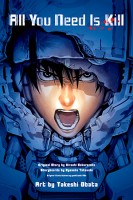 Author: Ryosuke Takeuchi
Author: Ryosuke Takeuchi
Illustrator: Takeshi Obata
Original story: Hiroshi Sakurazaka
U.S. publisher: Viz Media
ISBN: 9781421576015
Released: November 2014
Original release: 2014
It’s been a few years since I’ve read Hiroshi Sakurazaka’s novel All You Need Is Kill but I distinctly remember enjoying it, perhaps even more than I initially thought that I would. And so, I was very excited to learn that Takeshi Obata would be working on the manga adaptation not only because I like the original All You Need Is Kill but because I also enjoy Obata’s illustrations. (Hikaru no Go, which he worked on, actually happens to be one of my favorite manga series.) I was even more excited when Viz Media licensed the All You Need Is Kill manga for an English-language release. In Japan, the series was published in 2014 in two volumes. Viz’s digital release was also two volumes, but its 2014 print edition was released as a single-volume omnibus under the Shonen Jump Advanced imprint complete with color pages and a larger trim size. While Obata provided the artwork for the manga adaptation of All You Need Is Kill, it was Ryosuke Takeuchi who outlined the script and storyboards.
Humankind has been at war with the Mimics for years, but it seems like it may be a losing battle. The Mimics, alien creatures that continue to evolve with each confrontation, have begun to close in on Japan, the only country remaining that has the ability to produce the high-tech battle jackets used in the war. If Japan is lost, the rest of the world will soon follow. Keiji Kiriya is a young jacket jockey about to face his first battle. He, like so many others, is killed in action, except that he then revives in his bunk, thirty hours before his death. At first Keji thinks he’s dreaming, but then it happens again. And then again. Time after time, Keiji lives and dies fighting against the Mimics. Doing all that he can to survive just a little bit longer each round, Keiji focuses part of his attention on Rita Vrataski, considered to be the best jacket solider in the world. Following her example, Keiji might actually have a chance to escape the time loop alive.
Because I haven’t recently read Sakurazaka’s original All You Need Is Kill it is difficult for me to make a detailed comparison between it and the manga adaptation. Generally though, I feel that the novel is the stronger work of the two, but the manga has quite a bit going for it as well. Most of the resigned humor and social commentary found in the novel and even Keiji’s internal development have been downplayed in the manga in favor of the story’s external spectacle, action, and battles. As manga is a visual medium it makes sense to have this slight change of focus, but as a result All You Need Is Kill does lose some of its emotional impact. As for the artwork itself, Obata does an excellent job conveying the drama of the plot. The jackets and heavy action sequences look great, too. The Mimics’ design does leave something to be desired though—they aren’t as terrifying as they should be—and some readers may find the occasional fanservice more distracting than anything else.
Although it may not have the same substantive weight of the original, All You Need Is Kill makes for an entertaining and exciting, action-packed manga that reads quickly. Though not without flaws, it succeeds well as an adaptation and as its own work. Particularly effective is how Obata emphasizes the time loop by utilizing very similar panels but with slightly different page layouts with each rewind, keeping the manga from becoming too repetitive. The way Obata draws Keiji changes as well. The young soldier becomes stronger and harder with each loop, but also more haunted and battle-weary. An explanation for the time abnormality is eventually given that at least makes sense superficially and sets up a nice plot twist, but it starts to fall apart if given too much critical thought. Still, the All You Need Is Kill is a great read for anyone interested in military science fiction and action. For the most part I was pleased with the adaptation; I’d still recommend that readers give the original novel a try, too, though.

Speak Your Mind